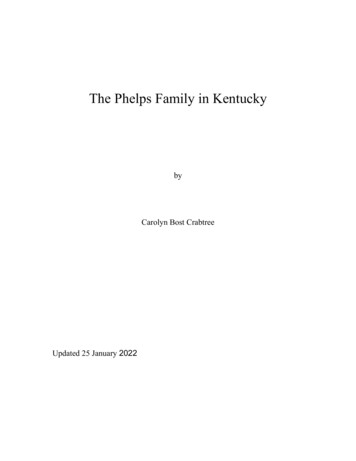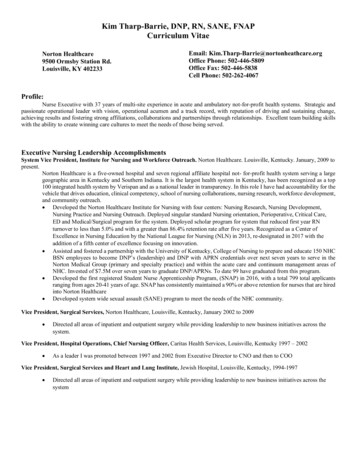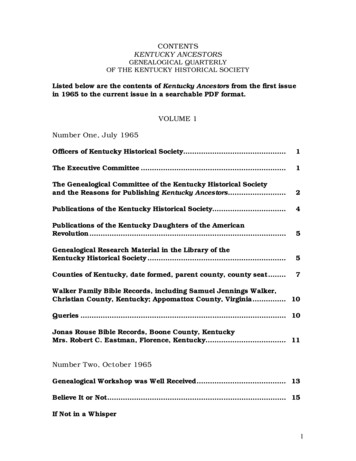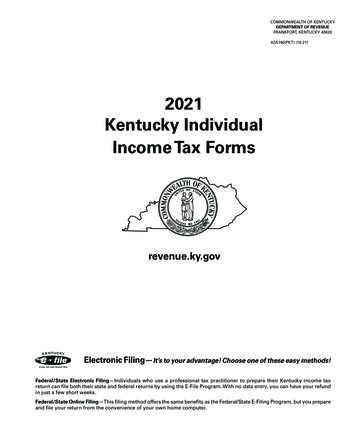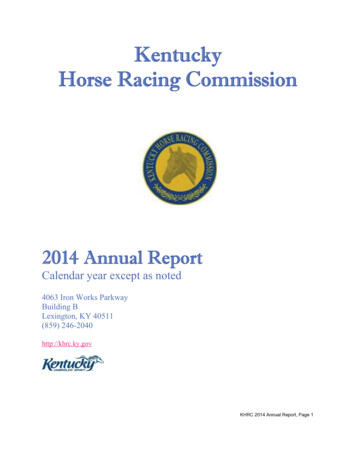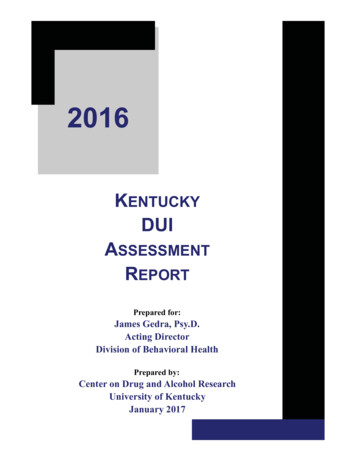
Transcription
2016KENTUCKYDUIASSESSMENTREPORTPrepared for:James Gedra, Psy.D.Acting DirectorDivision of Behavioral HealthPrepared by:Center on Drug and Alcohol ResearchUniversity of KentuckyJanuary 2017
2016 Division of Behavioral HealthDriving Under the Influence ProgramDUI Program Manager—Lee Etta CummingsCentral Region Coordinator—Deniece BellEastern Region Coordinator—Wilma TerryWestern Central Region Coordinator—Megan KisselWestern Region Coordinator—Stephen ShoreThis report was developed under a contract from the Kentucky Division of BehavioralHealth, Department for Behavioral Health, Developmental and Intellectual Disabilities tothe University of Kentucky Center on Drug and Alcohol Research. The followingindividuals contributed to data preparation, data analysis, writing, and production of thisreport: Matthew Webster (Principal Investigator), Megan Dickson, and Steve Cook.Copies of this report can be requested by emailing the Kentucky DUI Project atkydui@uky.edu. Previous DUI assessment annual reports and related information can befound on the project’s website http://cdar.uky.edu/dui/.
TABLE OF CONTENTSEXECUTIVE SUMMARY . 5BACKGROUND . 7DEMOGRAPHICS . 131.1Number of DUI Assessments Submitted in 2016 . 151.2DUI Assessments by Gender . 161.3Assessments by Race/Ethnicity . 171.4Assessments by Age . 171.5Assessments by Income . 181.6Assessments by DUI Convictions. 19SUBSTANCES INVOLVED IN DUI ARREST. 212.1Assessments by Substance(s) Involved in DUI Arrest . 232.2Substance(s) Involved in DUI Arrest by Gender . 242.3Substance(s) Involved in DUI Arrest by Race/Ethnicity . 242.4Substance(s) Involved in DUI Arrest by Age . 252.5Substance(s) Involved in DUI Arrest by DUI Offense Type . 262.6Biological Tests for the Presence of Alcohol and Drugs . 262.7Substance(s) Involved in DUI Arrest by Blood Alcohol Content . 27SCREENING . 293.1AUDIT and DAST by Gender . 313.2AUDIT and DAST by Race/Ethnicity . 323.3AUDIT and DAST by Age . 323.4AUDIT and DAST by Substance(s) Involved in DUI Arrest . 333.5AUDIT and DAST by DUI Offense Type . 333.6DSM-5 Substance Use Disorders by Gender . 343.7DSM-5 Substance Use Disorder Severity for Alcohol and Drugs . 353.8DSM-5 Substance Use Disorders by Substance(s) Involved in DUI Arrest . 363.9DSM-5 Substance Use Disorders by DUI Offense Type. 373.10 DSM-5 Substance Use Disorders by Blood Alcohol Content . 38TREATMENT REFERRALS . 414.1Level of Care Recommended. 434.2Total Referrals . 444.3Recommended Level of Care by Gender . 454.4Recommended Level of Care by Race/Ethnicity . 454.5Recommended Level of Care by Age . 464.6Recommended Level of Care by Substance(s) Involved in DUI Arrest . 474.7Recommended Level of Care by Blood Alcohol Content . 474.8Recommended Level of Care by DSM-5 Substance Use Disorders. 483
COMPLIANCE. 515.1Compliant vs. Non-Compliant . 535.2Compliance by Gender . 545.3Compliance by Race/Ethnicity . 545.4Compliance by Age. 555.5Compliance by DUI Offense Type . 555.6Compliance by Substance(s) Involved in DUI Arrest . 565.7Compliance by AUDIT Scores . 565.8Compliance by DAST Scores . 575.9Compliance by DSM-5 Substance Use Disorders . 575.10 Compliance by Highest Level of Care Recommended . 58MHMR REGIONS. 616.1Assessments . 636.2Mental Health/Mental Retardation (MHMR) Regions . 636.3Past DUI Convictions . 646.4MHMR Regions and Blood Alcohol Content . 666.5MHMR Regions and Screening Instruments . 676.6MHMR Regions and Level of Care . 69DIVISION OF BEHAVIORAL HEALTH REGIONS . 717.1Number of Assessments and Demographics by DBH Region. 737.2Blood Alcohol Content by DBH Region . 737.3Screening Instruments by DBH Region . 747.4Level of Care and Compliance by DBH Region . 757.5Substance(s) Involved in DUI Arrest by DBH Region . 76REFERENCES . 79APPENDICES . 834
Executive SummaryExecutive SummaryIn calendar year 2016, there were approximately 131 licensed and certified DUIAssessment Programs and 17,859 DUI assessment records were submitted to theKentucky Division of Behavioral Health. These records include education and treatmentinformation for persons convicted of DUI who were assessed and referred for anintervention. Using the web-based Kentucky DUI Assessment Instrument, records aresubmitted by certified DUI assessors once the initial substance abuse assessment isperformed. The University of Kentucky Center on Drug and Alcohol Research iscontracted by the Division of Behavioral Health, Department for Behavioral Health,Developmental and Intellectual Disabilities to receive these records from DUI assessmentprograms and to maintain this information in a database. This report provides informationon assessments conducted from January 1, 2016 through December 31, 2016 and alsoprovides trends from 2007 to 2016.The typical person receiving a substance abuse assessment as a result of a DUI convictionin Kentucky in 2016 was a low-income white male in his 20’s who was convicted of afirst offense DUI with a blood alcohol level between 0.08 and 0.15 g/dL, met DSM-5diagnostic criteria for a substance use disorder in the past 12 months, and was referred toeither a 20-hour education intervention or to outpatient substance abuse treatment. For 2016, the number of DUI Assessments submitted was 17,859.Gender:o Males74.1%o Females25.9% Program referrals* were made to:o 20-Hour Education43.6%o Outpatient53.0%o IOP or Residential3.4%*Only the highest level of care is presented forpersons referred to more than one level of care The number of DUI assessment records has been decreasing since 2013. DUIarrests and convictions have also decreased overall. Overall, 82.0% of the assessments completed in 2016 were for DUI clients whowere compliant with their education/treatment referrals. Persons who were noncompliant were most likely to have been under 40 years of age, AfricanAmerican, have multiple DUI convictions, and met at least two DSM-5 substanceuse disorder criteria in the past 12 months. Additionally, non-compliant personsscored higher on the AUDIT and DAST screening instruments and were under theinfluence of drugs at the time of their current DUI. Possessing multiple riskfactors appears to increase the risk of non-compliance.5
Executive Summary The number of DUI assessments completed for male clients continues to decrease.It has dropped by nearly 6 percentage points since 2007. More than three-quarters (79.5%) of assessments submitted in 2016 that reportedincome information were for individuals with a household income less than 30,000. Nearly one in five DUI clients who were convicted of a first DUI offense had atleast one other DUI offense in their lifetime. 28.0% of assessments submitted in 2016 were for DUI clients under the influenceof drugs at the time of their DUI arrest – an increase from 2015. Clients convictedof a first DUI offense and those under the age of 40 were more likely to reportbeing under the influence of drugs. In 2016, DUI assessment records indicated that female clients were more druginvolved than their male counterparts. Female DUI clients were more likely tohave a positive DAST score (32.3% vs. 23.7%), more likely to report a drug usedisorder (24.9% vs. 17.6%), and more likely to report that their current DUIoffense involved drugs (38.2% vs. 24.4%). DUI clients assessed in the Western-Central region of Kentucky were the mostlikely to report that their current DUI involved alcohol (90.1%). Clients in theWestern-Central region also had the highest average AUDIT score and were mostlikely to report an alcohol use disorder according to DSM-5 criteria (56.3%). Drug problems, as measured by the DAST screening instrument, were mostprevalent among DUI offenders in the Eastern region of Kentucky. Offenders inthe Eastern region also had the highest rate of drug-involved DUIs (47.9%). During 2016, DUI offenders were more likely to be referred to outpatient (53.0%)than education (43.6%) or any other form of treatment (3.4%). The percentage ofclients referred to outpatient treatment as the highest level of care has beensteadily increasing since 2013, while education-only referrals have decreased. Underage DUI clients ( 21 year old; 56.2%) and individuals 60 years old andolder (52.4%) were more likely to be referred to an education program than thosein other age groups.6
BACKGROUNDBACKGROUND7
BACKGROUNDThis page left intentionally blank.8
BACKGROUNDStudy OverviewThe Kentucky Revised Statute 189A.040 requires Kentucky licensed drivers convicted ofDriving Under the Influence (DUI) to receive a substance abuse assessment by a statecertified DUI assessor in a state licensed and certified DUI assessment program1. DUIAssessment programs are required (908 KAR 1:310 Section 6(1)(a)4) to enter assessmentrecords via the web-based Kentucky DUI Assessment Instrument (KDAI) within three(3) business days of the assessment. The University of Kentucky Center on Drug andAlcohol Research (CDAR) serves as the repository for state DUI assessment records. Thedata is stored in a database from which this report was developed.The purpose of the assessment is to determine the extent to which the person has analcohol and/or drug problem and to make a referral to an appropriate level of care toaddress it. If treatment need is determined, a person can be referred to one or more of thefollowing treatment modalities: outpatient, intensive outpatient, or residential treatment.Referral may also include an education intervention or an education intervention coupledwith treatment. If a person finishes their education and/or treatment requirementsconsistent with his or her referral within a stipulated timeframe, the person is considered“compliant.” However, if the person fails to meet the referral requirements, he/she isconsidered “non-compliant.” In either case, once a person is designated as compliant ornon-compliant, that assessment record is “completed.” Assessment records previouslysubmitted using KDAI are updated to include completion information once an individualis identified as compliant or non-compliant.Data DescriptionDUI assessment records provide demographic information about the person, informationabout their DUI offense, results of the assessment, and education/treatment information.Demographic information includes age, gender, race/ethnicity, and household income. Inaddition, source of payment (e.g., self-payment) for DUI services is recorded. DUIoffense information includes current DUI information, DUI conviction history, andcounty of conviction. Records include three assessment instruments: Alcohol Use Disorders Identification Test (AUDIT)2 – The AUDIT wasdeveloped by the World Health Organization as a screening method for excessivedrinking. The test consists of 10 questions scored from 0 to 4. A combined scoreof 8 or more is considered as positive (i.e., the individual is likely to have adrinking problem). Drug Abuse Screening Test (DAST)3 – The DAST was developed to assess theextent of drug problems. The test consists of 28 true/false questions with a scoreof 1 or 0. A combined score of 5 or more is considered as positive (i.e., theindividual is likely to have a drug problem). DSM-54 checklist for Substance Use Disorders. The Diagnostic and StatisticalManual, Fifth Edition (DSM-5) was developed by the American PsychiatricAssociation as the standard for psychiatric diagnoses. The DSM-5 specifies threecategories of substance use disorders: mild, moderate and severe. Meeting 2-3criteria for a single substance within a 12-month period indicates a mild disorder;9
BACKGROUND4-5 criteria, a moderate disorder; and 6 criteria or more, a severe substance usedisorder.Information about the intervention referral is also noted. This includes the educationand/or level(s) of treatment to which the person is referred, as well as the person’scompliance with that referral.SampleThis report presents DUI assessment records for assessments conducted between January1, 2016 and December 31, 2016 as well as trends detailing changes in assessment resultsover the past several years. In 2016, a total of 17,859 assessment records were entered bylicensed and certified DUI assessors. It should be noted that the number of submittedassessment records in 2016 is not the same as the number of completed assessmentrecords or the number of DUI convictions in 2016 because persons can be convicted, beassessed, and complete their intervention in separate years. Of the 17,859 assessmentsconducted in 2016, only 13,413 assessment records were also “completed” beforeDecember 31, 2016. Additionally, the number of assessment records is not equal to thenumber of unique individuals. A single person can have multiple DUI assessment recordsin a single calendar year either because of multiple DUI convictions or because they hadto be reassessed due to non-compliance.LimitationsThere are several limitations to these data. First, there is the issue of incomplete,erroneous, and/or missing data. Table 1 presents the level of missing data.Table 1: Missing DataAgeRaceHousehold IncomeBlood Alcohol ContentAUDITDASTDSM-5Recommended Level of Care2016MissingPercentageAssessmentsof %00.0%00.0%Although KDAI has successfully reduced the amount of missing data when compared tothe previous DUI assessment record system, certain fields remain problematic. BloodAlcohol Content has the highest percentage of missing cases, which is largely due toindividuals who were not tested, refused the test, or did not remember the level. Othervariables, such as race and household income, have a significant amount of missing casesbecause they are optional fields.10
BACKGROUNDThe second limitation is that these data represent a subset of a larger, unknown number ofDUIs in Kentucky. For example, in 2015 there were 23,024 DUI arrests and 14,286completed assessments5. This difference emphasizes the dangers in comparingfrequencies of arrests, convictions, and assessments as there are different requirementsand timelines for compiling each of these types of records. Figure 1 presents the numberof DUI arrests and convictions submitted to the Kentucky State Police, and completedDUI assessment records for 2006 through 2015. 2016 data were not available at the timethis report was written.Figure 1: DUI Arrests, DUI Convictions, and Completed Records, 2006 through 1320142015Completed Assessment Records* Arrest and conviction data from Kentucky State Police were only available through 2015 at the timethis report was developed.This report presents DUI assessment records submitted in 2016, which are independent ofviolation date and conviction date. Caution should be used in comparing these data toother data. For example, a portion of the unaccounted records includes out-of-statelicensees who are arrested in Kentucky but are not required to receive a Kentuckyassessment. Assessments would also not be completed or submitted for persons who areincarcerated for an extensive period of time following their DUI. In addition, personswho are arrested for DUI may plea bargain to a lesser charge.A third limitation is that most of the data are self-reported, which can be limited by recall.11
BACKGROUNDThis page left intentionally blank.12
DEMOGRAPHICSSECTION ONEDEMOGRAPHICS13
DEMOGRAPHICSThis page left intentionally blank.14
DEMOGRAPHICS1.1 Number of DUI Assessments Submitted in 2016The number of DUI assessments submitted by licensed and certified DUI programs incalendar year 2016 was 17,859. Figure 1.1 presents the number of assessmentssubmitted to CDAR on behalf of the Division of Behavioral Health from 2007through 2016. The average number of assessments received has been 19,632 per year.Figure 1.1: Number of Assessments 2007 to 92010201120122013201420152016In 2015, there were 23,024 arrests for DUI, which represented 6.1% of all arrests inKentucky in that year. Figure 1.2 presents the number of DUI arrests from 2006 to2015 and the percentage of total arrests in Kentucky those DUIs represent.Figure 1.2: Number of DUI Arrests and Percentage of Total Arrests 2006 to 201513%40,00012%33,08929,91730,00025,839 26,05025,00020,00015,00011%24,16022,555 0007%6.7%6.3% 6.1%Percentage of Total ArrestsNumber of DUI Arrests35,00034,997 35,252 34,3066%5%2006 2007 2008 2009 2010 2011 2012 2013 2014 2015Number of DUI ArrestsPercentage of Total Arrests* Arrest and conviction data from Kentucky State Police were only available through 2015 at the timethis report was developed.15
DEMOGRAPHICS1.2 DUI Assessments by GenderOf the 17,859 assessments submitted in 2016, 13,241 (74.1%) were for males and4,618 (25.9%) were for females.Males74.1%Females25.9%Figure 1.3:Assessments by Gender** Missing Data 0 AssessmentsFigure 1.4 presents the percentage of assessments that were for males from 2007through 2016. The percentage of males has slowly decreased over the past ten years.Figure 1.4: Percentage of Assessments that were for Males 2007 to 2016Percentage for %75.0%70%2007200820092010162011-122013201420152016
DEMOGRAPHICS1.3 Assessments by Race/EthnicityOf those assessments for which race was reported in 2016, the majority were forWhite DUI clients (84.8%), while only 1,535 assessments (10.2%) were submitted forAfrican Americans and 754 (5.0%) were submitted for Hispanics or those of anotherracial/ethnic background. Figure 1.5 presents the number of assessments byrace/ethnicity.1.4%3.6%10.2%Figure 1.5:Assessments by Race/Ethnicity*84.8%* Missing Data 2,758 AssessmentsRace/Ethnicity is an optional field in KDAI.WhiteAfrican AmericanHispanicOther1.4 Assessments by AgeThe majority of assessments were for DUI clients between 21 and 39 years old at thetime of conviction (57.1%). There were 1,050 assessments (5.9%) submitted for DUIclients who were between 16 and 20 years old. Figure 1.6 presents the number ofassessments by age at conviction.Figure 1.6: Assessments by Age at Conviction*16 to 201,0505.9%21 to 2930.4%5,43030 to 394,76840 to 493,45150 to 592,37460 to 6967270 to ,0006,000Number of Assessments* Missing Data 3 Assessments177,0008,0009,000
DEMOGRAPHICSFigure 1.7 presents the number of assessments for underage DUI clients ( 21 yearsold), which has declined overall since 2007.Assessments for DUI Clients 21 years oldFigure 1.7: Percentage of Assessments that were for Underage DUI Clients 2007 0%20072008200920102011-1220132014201520161.5 Assessments by IncomeTable 1.1 presents the number of DUI assessments by yearly household incomerange. The majority of assessments were conducted for individuals who had ahousehold income level less than 20,000 (61.9%).Table 1.1: Assessments by Yearly Household Income*Household IncomeNumber of AssessmentsAffidavit of Indigence 0 to 9,999 10,000 to 19,999 20,000 to 29,999 30,000 to 39,999 40,000 to 49,999134,8603,8332,4811,305628 50,000 to 59,999 60,000 to 69,999 70,000 to 79,999 80,000 to 89,999 90,000 to 99,999 100,000 or higher3611901176651160* Missing Data 3,794 Assessments18
DEMOGRAPHICS1.6 Assessments by DUI ConvictionsFigure 1.8 presents frequencies of lifetime DUI convictions. This number includes theDUI conviction that resulted in the current assessment.Number of Lifetime DUI ConvictionsFigure 1.8: DUI Assessments by Lifetime DUI Convictions*2,4973 63.1%12,000Number of Assessments* Missing Data 0 AssessmentsFigure 1.9 presents the frequencies of each DUI offense type (e.g., convicted of a firstoffense) for assessments conducted in 2016.Figure 1.9: DUI Assessments by Offense Type*DUI Offense Type3rd orhigher738 mber of Assessments* Missing Data 0 Assessments1977.2%15,00018,00021,000
DEMOGRAPHICSFigure 1.10 presents the percentage of assessments for individuals convicted of atleast a second DUI offense. The percentage of DUI clients convicted of a second orhigher DUI offense has remained relatively stable since 2007.Figure 1.10: Percentage of Assessments for Persons Convicted of at least a 2ndOffense DUI between 2007 and 2016Percentage with Multiple ographics SummaryThree out of four DUI assessments were for males and more than 80.0% were forWhite persons. The majority were also for persons between 21 and 39 years old, with5.9% of assessments being for persons younger than 21. More than one-third were forpersons who had two or more lifetime DUI offenses, while 22.8% were convicted ofsecond or higher DUI offense.20
SUBSTANCESSECTION TWOSUBSTANCES INVOLVED IN DUI ARREST21
SUBSTANCESThis page left intentionally blank.22
SUBSTANCES2.1 Assessments by Substance(s) Involved in DUI ArrestThe majority of assessments submitted in 2016 were for DUI arrests that involvedonly alcohol (72.0%). Around one-fourth (28.0%) of assessments were DUI arreststhat were drug-involved, either drug-only DUIs or DUIs that involved both drugs andalcohol. The type of drugs involved in DUIs in 2016 included marijuana (11.1%),opiates (9.0%), and sedatives (5.2%). Figures 2.1 and 2.2 present the number of DUIassessments by the substance(s) involved.5.6%72.0%22.4%Figure 2.1:Assessments by Type ofSubstance(s) Involved in DUI Arrest ** Missing Data 36 AssessmentsAlcohol-OnlyDrug-OnlyAlcohol DrugFigure 2.2: Assessments by Specific Substance Involved in DUI tes5.2%7.6%SedativesOther0%Alcohol* Other includes cocaine, amphetamines, inhalants, hallucinogens, PCP, and an “other drug” category.23
SUBSTANCES2.2 Substance(s) Involved in DUI Arrest by GenderFigure 2.3 presents the type of substance(s) involved by gender of individualsconvicted of DUI. Both male and female DUI clients were most often involved in analcohol-only DUI. Female clients, however, were more likely (38.2%) to have a druginvolved DUI than male clients (24.4%).Percentage of AssessmentsFigure 2.3: Substance(s) Involved in DUI Arrest by .4%0%MaleFemaleAlcohol-OnlyDrug-OnlyAlcohol Drug* Missing Data 36 Assessments2.3 Substance(s) Involved in DUI Arrest by Race/EthnicityFigure 2.4 presents the type of substance(s) involved by race/ethnicity. In 2016,White DUI clients were the most likely to have driven under the influence of drugswhile a higher percentage of Hispanic DUI clients (93.4%) were involved in alcoholonly DUIs compared to other racial/ethnic categories.Figure 2.4: Substance(s) Involved in DUI Arrest by 12.5%5.8%0%WhiteAfrican ol Drug* Missing Data 2,788 Assessments. Race/Ethnicity is an optional field in KDAI.2413.4%6.2%Other
SUBSTANCES2.4 Substance(s) Involved in DUI Arrest by AgeIn 2016, there was a relationship between the DUI client’s age at conviction and thetype of substance(s) involved in the current DUI. Compared to other age groups,older persons were more likely to be involved in an alcohol-only DUI, whereasclients between the ages of 16 and 39 were more likely to be involved in a drug-onlyDUI. Figure 2.5 presents the type of DUI for each age group.Figure 2.5: Substance(s) Involved in DUI Arrest by Age at Conviction*100%88.3%80%Percentage of 5.4%0%16 to 2021 to 2930 to 3940 to 4950 to 5960 to 69Age GroupsAlcohol-OnlyDrug-Only* Missing Data 39 Assessments256.3%4.9%Alcohol Drug70 to 89
SUBSTANCES2.5 Substance(s) Involved in DUI Arrest by DUI Offense TypeFigure 2.6 presents the relationship between the substance involved in the DUI andthe DUI offense type. DUI clients convicted of a first offense DUI were most likely tohave a drug-only DUI (23.4%), while those who were convicted of at least a secondDUI offense were most likely to have an alcohol-involved DUI.Figure 2.6: Substance(s) Involved in DUI Arrest by DUI Offense %6.3%5.5%5.0%0%1st2nd3rd or higherDUI Offense TypeAlcohol-OnlyDrug-OnlyAlcohol Drug* Missing Data 36 Assessments2.6 Biological Tests for the Presence of Alcohol and DrugsA majority of DUI clients reported that they were tested for alcohol during theircurrent DUI arrest (59.1%). Of the 10,563 clients who were tested, a majority hadtheir breath tested (88.1%). Figure 2.7 presents the number of assessments by methodof alcohol test.0.1%11.8%Figure 2.7:Assessments by BACMeasurement Method*88.1%* Missing Data 0 AssessmentsNot Tested 7,296 IndividualsBlood26UrineBreath
SUBSTANCESA smaller percentage of DUI clients were drug tested with their current DUI (18.6%).Of the 3,326 tested, most had their blood tested (96.6%). Figure 2.8 presents thenumber of DUI assessments by method of drug testing.3.4%Figure 2.8:Assessments by Drug Test Method*96.6%* Missing Data 0 AssessmentsNot Tested 14,533 IndividualsBloodUrine2.7 Substance(s) Involved in DUI Arrest by Blood Alcohol ContentFigure 2.9 presents trends for BAC and the type of substance(s) involved in thecurrent DUI. There was a relationship between BAC and type of DUI, with higherBACs reported for individuals involved in alcohol-only DUIs.Figure 2.9: Substance(s) Involved in DUI Arrest by Blood Alcohol Content*100%97.5%97.8%98.5%2.5%2.2%1.5%0.0%.16 to .23.24 to .31Percentage of Assessments95.2%80%60%67.1%40%30.8%20%2.1%0%.00 to .074.5%0.3%.08 to .15.32 Blood Alcohol ContentAlcohol-OnlyDrug-OnlyAlcohol Drug* Missing Data 9,117 Assessments. This includes both alcohol- and drug-involved offenders.27
SUBSTANCESSubstances SummaryMore than 3 out of 4 DUI assessments were for DUIs that inv
prevalent among DUI offenders in the Eastern region of Kentucky. Offenders in the Eastern region also had the highest rate of drug-involved DUIs (47.9%). During 2016, DUI offenders were more likely to be referred to outpatient (53.0%) than education (43.6%) or any other form of treatment (3. The 4%).percentage of

